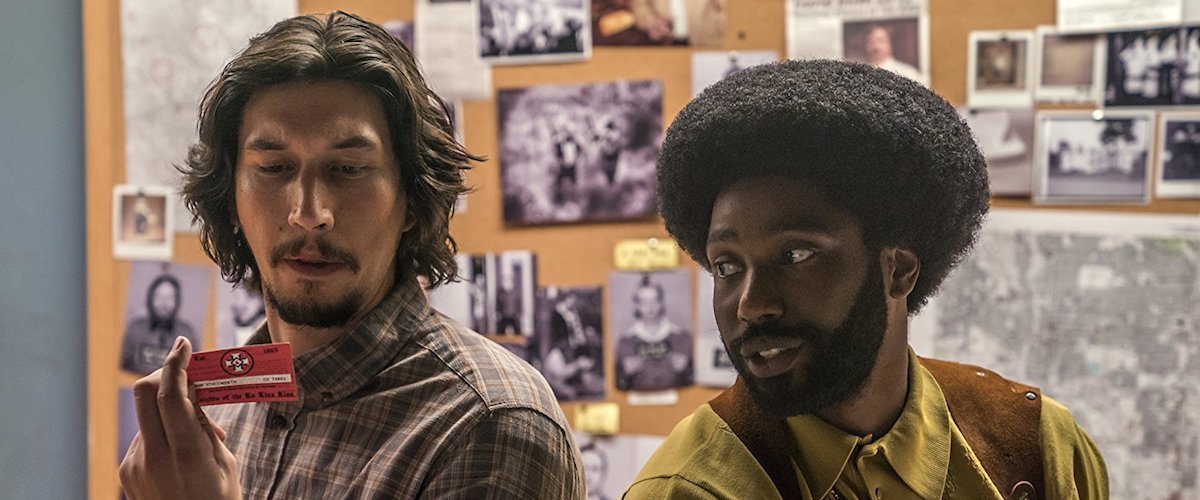In 1992, Denzel Washington starred in Spike Lee’s film, Malcolm X. Now his son takes centre stage in Lee’s newest film, BlacKkKlansman. John David Washington takes on the challenge of playing Ron Stallworth, the first African American cop in Colorado Springs Police Department. Set in the ‘70s, this true story raptures audiences. Washington owns his scenes, and performs with conviction and heart.
The story unfolds as Stallworth finds himself in the records room, dissatisfied and the constant victim of a particularly racist coworker. He manages to convince his chief that he is capable of more, and lo and behold, flipping through the paper, he stumbles across an advertisement for the Ku Klux Klan, complete with a phone number. What motivates him to call is unclear, but his fingers dial the number on that rotary phone, and after a beat he speaks to the president of the local KKK chapter, Walter Breachway.
He manages to convince Breachway that he is white, and in total agreeance with what the organization stands for, and is invited to meet the rest of the members. One problem: Stallworth isn’t quite the right fit for the KKK. His partner, Phillip “Flip” Zimmerman (played by Adam Driver of Star Wars fame), a Jewish American, steps in, and the two become one character: the white supremacist American man.
Zimmerman must deny his background, given that the Klan despises Jewish Americans as well. Going through his whole life as a normal white American, Zimmerman must now face the reality of his ancestry. In a reflective moment, Zimmerman admits to Stallworth, “I’ve never thought much about it. Now I think about it all the time.”
As the story progresses the viewer notices the not-so-subtle allegorical nods and connections to the reality we are living in now. In a moment between Stallworth and his boss, the conversation turns to how the racism will turn subtle. It will use nuanced language, affirmative action, immigration, and tax reform to sell the idea of racism. “Under all these issues, everyday Americans can accept it, support it, until eventually you get somebody in the white house who embodies it.” This line is met with incredulous laughter from Stallworth, but it is a not-so-subtle jab at what is currently happening around us.
In one scene there is a very abrupt juxtaposition of a KKK meeting and Harry Belafonte meeting with the Black Student Union, each of them enthralled and appalled at the thread Belafonte unravels. The viewers are catapulted back and forth between the story of a young black man, convicted in four minutes of a crime he didn’t commit, and the brutal murder that took place as the sentence. Pictures of the event flash across the screen, and a split second later Birth of a Nation, the horrendous “blockbuster” of KKK propaganda is seen with the jubilant cries of the supremacists cheering on the deaths of those whose skin varies from theirs. It’s hard to watch, to stomach — the two extremes. It’s nauseating to believe that people could root so heartily for the death of another.
The portrayal of the Klansman seems like an overdone caricature, almost so overdone that it leaves me incredulous that people such as these exist. With a wife snuggling her racist, jerk of a husband in bed, dreaming of killing African Americans (the epithet for which is used liberally throughout), and a permanently drunk idiot of a Klansmen, I wonder if the exaggerated portrayal undercuts the film’s ability to hit its mark. While the movie does an amazing job of showing extremes, it fails to show the nuances in the everyday of racism. It left me sad, but also self-congratulatory, that it isn’t me donning a hood and spotless white robe.
The film ends with footage of recent events. Trump on the podium, unable to condemn the acts in Virginia. The horrendous footage of racists chanting at the University of Virginia. David Duke’s praise and support speech of Trump. The murderous rampage of the car on Water Street.
With Heather Heyer’s face still burning my retinas, I sit in the aftermath of watching BlacKkKlansman. Every inch of me wanted to change the channel in my mind to something less uncomfortable than facing this reality. Yet every inch of me knew the desperate importance of staying in, and contemplating, my state of discomfort.


